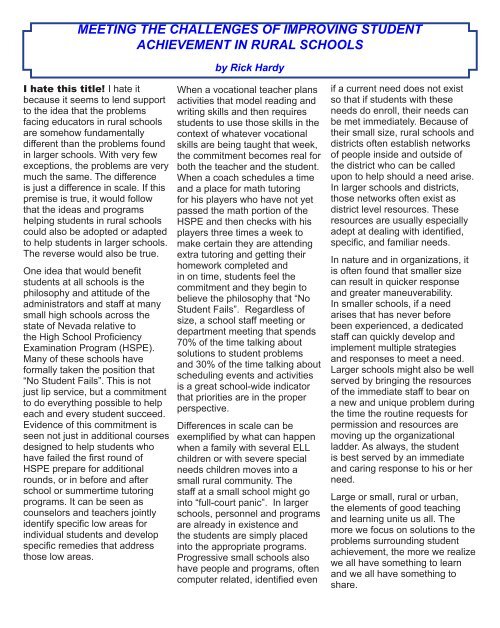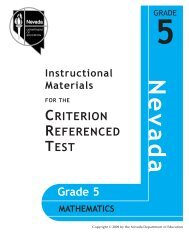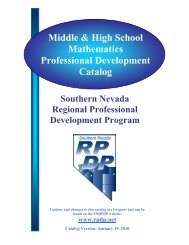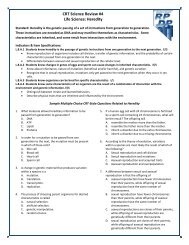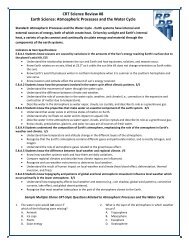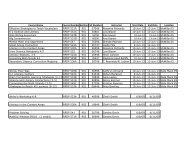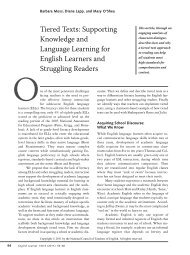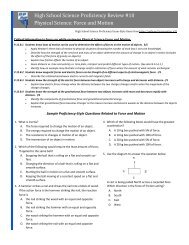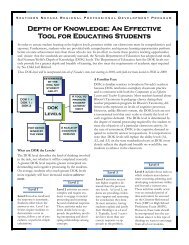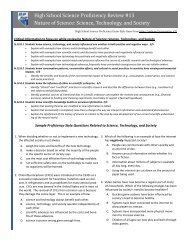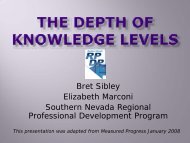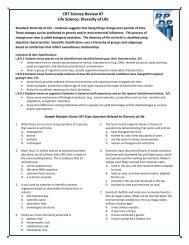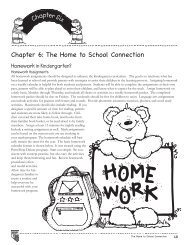Download - RPDP
Download - RPDP
Download - RPDP
You also want an ePaper? Increase the reach of your titles
YUMPU automatically turns print PDFs into web optimized ePapers that Google loves.
MEETING THE CHALLENGES OF IMPROVING STUDENT<br />
ACHIEVEMENT IN RURAL SCHOOLS<br />
by Rick Hardy<br />
I hate this title! I hate it<br />
because it seems to lend support<br />
to the idea that the problems<br />
facing educators in rural schools<br />
are somehow fundamentally<br />
different than the problems found<br />
in larger schools. With very few<br />
exceptions, the problems are very<br />
much the same. The difference<br />
is just a difference in scale. If this<br />
premise is true, it would follow<br />
that the ideas and programs<br />
helping students in rural schools<br />
could also be adopted or adapted<br />
to help students in larger schools.<br />
The reverse would also be true.<br />
One idea that would benefit<br />
students at all schools is the<br />
philosophy and attitude of the<br />
administrators and staff at many<br />
small high schools across the<br />
state of Nevada relative to<br />
the High School Proficiency<br />
Examination Program (HSPE).<br />
Many of these schools have<br />
formally taken the position that<br />
“No Student Fails”. This is not<br />
just lip service, but a commitment<br />
to do everything possible to help<br />
each and every student succeed.<br />
Evidence of this commitment is<br />
seen not just in additional courses<br />
designed to help students who<br />
have failed the first round of<br />
HSPE prepare for additional<br />
rounds, or in before and after<br />
school or summertime tutoring<br />
programs. It can be seen as<br />
counselors and teachers jointly<br />
identify specific low areas for<br />
individual students and develop<br />
specific remedies that address<br />
those low areas.<br />
When a vocational teacher plans<br />
activities that model reading and<br />
writing skills and then requires<br />
students to use those skills in the<br />
context of whatever vocational<br />
skills are being taught that week,<br />
the commitment becomes real for<br />
both the teacher and the student.<br />
When a coach schedules a time<br />
and a place for math tutoring<br />
for his players who have not yet<br />
passed the math portion of the<br />
HSPE and then checks with his<br />
players three times a week to<br />
make certain they are attending<br />
extra tutoring and getting their<br />
homework completed and<br />
in on time, students feel the<br />
commitment and they begin to<br />
believe the philosophy that “No<br />
Student Fails”. Regardless of<br />
size, a school staff meeting or<br />
department meeting that spends<br />
70% of the time talking about<br />
solutions to student problems<br />
and 30% of the time talking about<br />
scheduling events and activities<br />
is a great school-wide indicator<br />
that priorities are in the proper<br />
perspective.<br />
Differences in scale can be<br />
exemplified by what can happen<br />
when a family with several ELL<br />
children or with severe special<br />
needs children moves into a<br />
small rural community. The<br />
staff at a small school might go<br />
into “full-court panic”. In larger<br />
schools, personnel and programs<br />
are already in existence and<br />
the students are simply placed<br />
into the appropriate programs.<br />
Progressive small schools also<br />
have people and programs, often<br />
computer related, identified even<br />
if a current need does not exist<br />
so that if students with these<br />
needs do enroll, their needs can<br />
be met immediately. Because of<br />
their small size, rural schools and<br />
districts often establish networks<br />
of people inside and outside of<br />
the district who can be called<br />
upon to help should a need arise.<br />
In larger schools and districts,<br />
those networks often exist as<br />
district level resources. These<br />
resources are usually especially<br />
adept at dealing with identified,<br />
specific, and familiar needs.<br />
In nature and in organizations, it<br />
is often found that smaller size<br />
can result in quicker response<br />
and greater maneuverability.<br />
In smaller schools, if a need<br />
arises that has never before<br />
been experienced, a dedicated<br />
staff can quickly develop and<br />
implement multiple strategies<br />
and responses to meet a need.<br />
Larger schools might also be well<br />
served by bringing the resources<br />
of the immediate staff to bear on<br />
a new and unique problem during<br />
the time the routine requests for<br />
permission and resources are<br />
moving up the organizational<br />
ladder. As always, the student<br />
is best served by an immediate<br />
and caring response to his or her<br />
need.<br />
Large or small, rural or urban,<br />
the elements of good teaching<br />
and learning unite us all. The<br />
more we focus on solutions to the<br />
problems surrounding student<br />
achievement, the more we realize<br />
we all have something to learn<br />
and we all have something to<br />
share.


